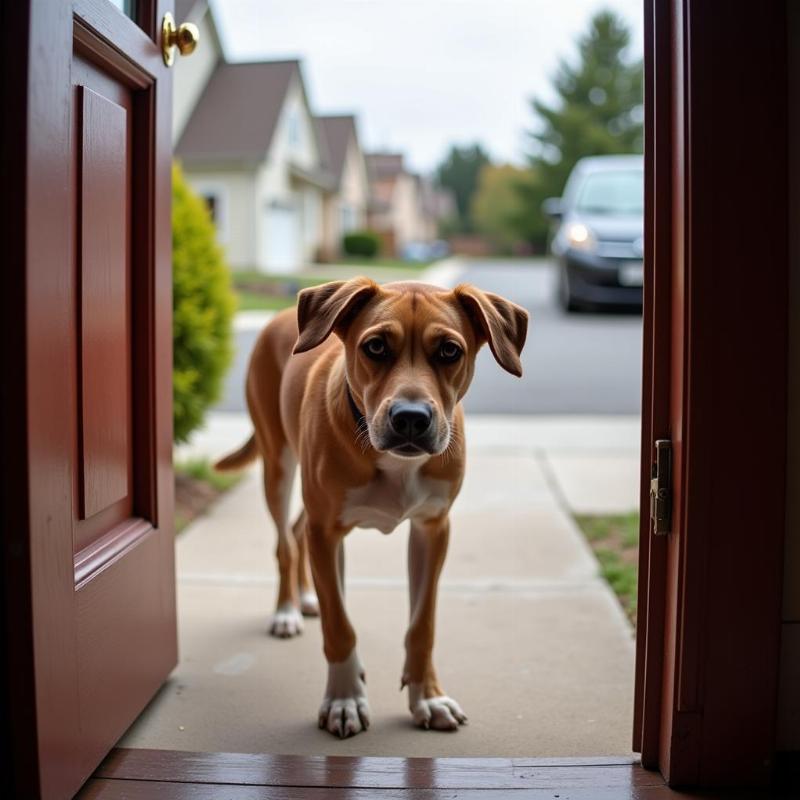If your dog suddenly refuses to venture outside alone, it can be perplexing and frustrating. This behavior, while sometimes seemingly out of the blue, often stems from identifiable causes ranging from fear and anxiety to medical issues. Understanding why your dog won’t go outside alone is the first step to helping them regain their confidence and enjoy the outdoors again.
Why is My Dog Suddenly Afraid to Go Outside Alone?
Several factors can contribute to a dog’s reluctance to go outside alone. Fear is a common culprit, triggered by loud noises like thunderstorms or fireworks, unfamiliar people or animals, or even changes in their environment. Anxiety, often manifesting as separation anxiety, can also make a dog hesitant to leave the perceived safety of their home. Medical conditions, such as arthritis, hip dysplasia, or injuries, can make going outside painful, leading to avoidance.
 Afraid dog hesitates to go outside
Afraid dog hesitates to go outside
Addressing Fear and Anxiety in Dogs
If fear is the root cause, gradual desensitization and counter-conditioning are effective techniques. Start by exposing your dog to the feared stimulus at a low intensity, rewarding them with treats and praise for calm behavior. Gradually increase the intensity while maintaining positive reinforcement. For anxiety, creating a safe and comfortable environment inside the home, providing puzzle toys to keep them occupied, and practicing short departures can help. Consulting with a certified dog trainer or veterinary behaviorist can offer personalized strategies.
Medical Reasons for Reluctance to Go Outside
If your dog exhibits signs of pain or discomfort when moving, a veterinary checkup is essential. Conditions like arthritis or injuries can make walking or even standing painful, making your dog reluctant to go outside. Your veterinarian can diagnose the problem and recommend appropriate treatment, such as medication, physical therapy, or other supportive measures.
Creating a Positive Outdoor Experience
Making the outdoors more appealing can encourage your dog to venture out. Start by accompanying them on short, enjoyable outings, focusing on positive reinforcement. Use high-value treats, favorite toys, and praise to create a positive association with being outside. Establish a routine for potty breaks and walks to provide predictability and reduce anxiety.
Conclusion
Addressing a dog’s reluctance to go outside alone requires patience, understanding, and a tailored approach. By identifying the underlying cause, whether fear, anxiety, or medical issues, and implementing appropriate strategies, you can help your dog regain their confidence and enjoy the outdoors once again. Remember that consistency and positive reinforcement are key to success.
FAQ
- My dog used to love going outside, why is he suddenly afraid? Sudden changes in behavior can be triggered by various factors, including a traumatic event, changes in the environment, or underlying medical conditions.
- How can I tell if my dog is in pain? Signs of pain in dogs can include limping, whining, changes in appetite, lethargy, and reluctance to move.
- When should I consult a veterinarian? If your dog exhibits sudden changes in behavior, signs of pain, or if you are unsure of the cause of their reluctance to go outside, it’s always best to consult a veterinarian.
- How long does it take to desensitize a dog to a fear? The time it takes to desensitize a dog varies depending on the severity of the fear and the individual dog. It’s a gradual process that requires patience and consistency.
- What are some good puzzle toys to keep my dog occupied indoors? Puzzle toys that dispense treats, such as Kongs or treat balls, can help keep your dog mentally stimulated and reduce anxiety.
- Can I use medication to help my dog’s anxiety? Medication can be an option for managing anxiety in dogs, but it’s crucial to consult with your veterinarian to determine the appropriate medication and dosage.
- How can I create a safe and comfortable environment for my dog indoors? Providing a cozy den-like area, access to fresh water, and maintaining a consistent routine can help create a safe and comfortable environment for your dog.
Related Articles
- dog barking in crate when i leave
- my dog won't stop barking when i leave
- stop dog from urinating on carpet
- dog hotel for aggressive dogs
Beautdogs.us is your premier resource for all things dog-related in the US. We offer expert advice on dog breeds, care, and products, catering to both new and experienced dog owners. We’re passionate about helping you build a strong and loving bond with your furry companion. For any inquiries, reach out to us via email at [email protected] or call us at +1 501-555-7529. Visit Beautdogs.us today!